At some point in your saltwater journey you will begin to add corals or Coralline Algae will begin to grow and the main path to success with coral is stability in your water parameters. I remember reaching this point and after several months of testing I was noticing some of my water parameters were dropping lower and lower. This was when I found out about Supplemental Dosing.
This is what I found out and implemented on my own system.
What Is Supplemental Dosing?
Dosing a saltwater aquarium is the process of adding trace elements like Calcium, Alkalinity, and Magnesium to the waterbecuase coral is consuming them faster than can be replenished with water changes alone. Dosing can be done manually or via automated liquid dosing pumps.
Once you begin to get Coralline Algae and you start adding corals to your aquarium, especially corals with hard skeletons like LPS and SPS they will begin to consume two main elements from your water.
The two main elements are Calcium, and Carbonate, more commonly referred to as Alkalinity, and they are used in conjunction with one another for the coral to build its hard skeleton. There is a third element that is also important to monitor and that is Magnesium. This needs to be in the correct range to allow these elements to stay free in the water to be absorbed and used by the coral.
The topic of how each of these elements works together is far too in-depth for this article, but this awesome video from Bulk Reef Supply explains everything:
So, in a nutshell, dosing is required to ensure the optimum levels of Calcium, Alkalinity, and Magnesium are maintained in your water so that your corals can grow.
Can Water Changes Replace Supplemental Dosing?
Regular water changes are usually able to keep up with the demand of trace elements the corals consume in tanks containing mainly soft and LPS coral. SPS and LPS corals consume the most and water testing is the only way to see if water changes are sufficient to keep up with consumption.
Water changes work really well for most aquarists that do not have a lot of coral or have an aquarium mainly consisting of soft corals like Mushrooms, Zoa’s & Palys, Kenya Trees, Pulsing Xenia, and GSP, to name a few.
These corals will still consume the elements, but because they are not building a hard skeleton they do not use anywhere near as much as LPS and SPS do.
You may find that your water changes will suffice and keep your levels stable for a long time, years in fact. The only way to monitor your water parameters is with regular testing with good-quality test kits.
If you do notice your Calcium, Alkalinity and Magnesium are beginning to drop slightly, the first thing you could do is change your salt.
This was my first step when I began adding corals. I initially ran Instant Ocean Salt, but then I switched to Instant Ocean Reef Crystals as it has higher levels of Calcium, Alkalinity, and Magnesium, specifically to help with coral growth.
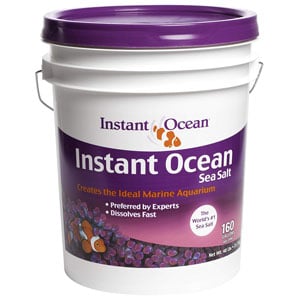
Find it Here at Amazon.com
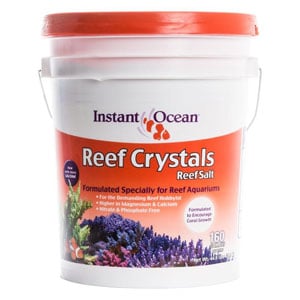
Find it Here at Amazon.com
Here is an extract from the Instant Ocean website regarding Reef Crystals…
“Instant Ocean Reef Crystals is an enriched formulation. Optimum effectiveness. Formulated specially for use in reef aquariums, Reef Crystals contains essential ocean reef elements in concentrations greater than those found in natural sea water. Extra Calcium to help ensure the growth of large and small polyp stony corals as well as coralline algae.
Extra Trace Elements to provide an additional measure of vital nutrients.
InstantOcean.com
Extra Vitamins to ensure vigorous growth and survival of corals, anemones and other invertebrates in a captive environment.
Metal Detoxifier – to neutralize traces of heavy metal often present in domestic water supplies.
As your corals grow, as you get more Coralline Algae, as you add more snails, the demand for those ions increase. Once the demand becomes more than what is being added each week by the water change, that becomes the time when you have to then start adding more.
For Example:
- You have a Hotdog Stand at your kids’ ball games
- Each week during the regular season you sell 50 hotdogs
- Your kids’ team gets into the playoffs
- Next week more people are at the ball game, you still only have 50 hotdogs but 60 people come to your stand.
- Next week 70 people come
- The week after that 80 people come
- If you cannot meet the demand, those people who came after the first 50 will start to get hungry. This is the same for your corals.
So how do you keep everyone happy? You get more hotdogs!
This is supplemental purchasing and is the same as supplemental dosing. Meeting the demand.
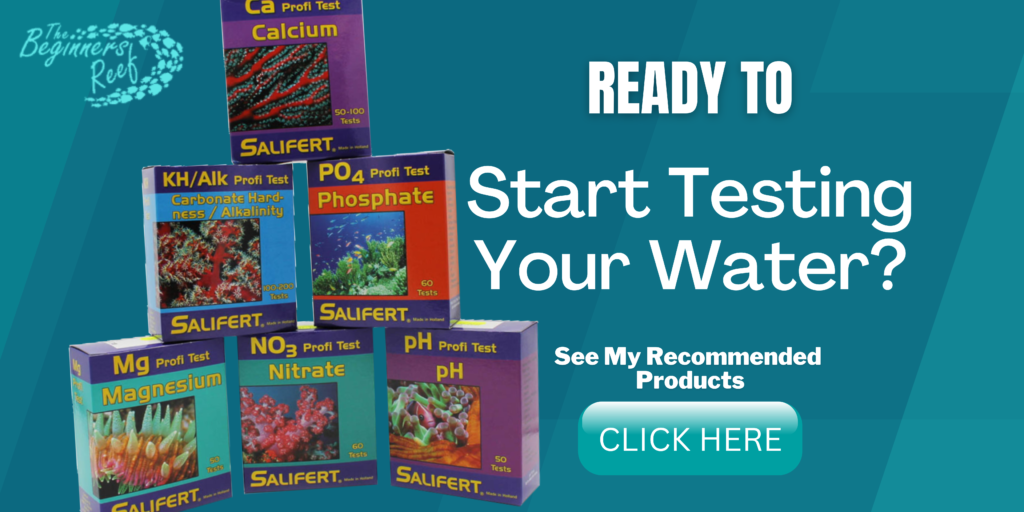
How Do You Dose An Aquarium?
There are a few ways in which to dose Cal, Alk, and Mag to your aquarium:
- Change of Salt
- Manually Adding
- Automatically Adding Via Dosing Pumps
- Calcium Reactor
1. Switch to Salts with Higher Trace Elements
This is usually the first way many aquarists try as it is the easiest. Instant Ocen Reef Crystals and Red Sea Coral Pro are the two most common salt mixes formulated with higher levels of calcium, alkalinity and magnesium for growing corals.
Try changing to one of these first and continue to test weekly for Alk, Cal, and Mag to see if they are able to maintain your levels. This might buy you another year or a few months, depending on how rapidly the demand increases.
Any One of the High-Quality Salt Mixes Below is a Great Option:
Reef Crystals
Coral Pro
Pro Reef
Reef Pro
2. Manually Dosing
Once your salt mix is unable to keep up the corals demand, now is the time you need to switch to supplemental dosing. It is really easy and once you have done it a few times you will soon have it mastered.
The easiest way, and the way myself and many other aquarists start is by purchasing a Manual 2-Part Starter Kit from Bulk Reef Supply:
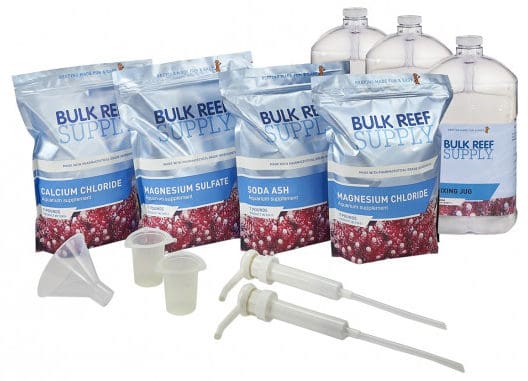
This $99 kit contains EVERYTHING you need to get started with dosing. Simple to mix, simple instructions and you will find it will last you a long time if your demand is small.
Don’t worry about it saying 2-Part. It contains granules to create liquid dosing solutions for Calcium, Alkalinity, AND Magnesium!
You can find out more information, reviews, and the Starter Kit Here at Bulk Reef Supply
The only part about manually adding a measured amount of dosing solution every day to your aquarium is that YOU have to do it EVERY DAY, or find someone to do it for you!
So what about when you are on vacation? This is where automation comes in!
3. Automated Dosing
This is where pretty much most aquarists will end up if they are dosing fluid solutions! Dosing manually can get a pain in the butt real quick! But there are simple solutions to this problem – Automated Dosing Pumps.
These are a simple pump that will pump very calibrated amounts slowly from your solution containers into the aquarium. They will pump when you want and exactly how much you want! Set & Forget!
There are two ways to start automated dosing:
1. The Bulk Reef Supply Starter Kit WITH included dosing pumps:
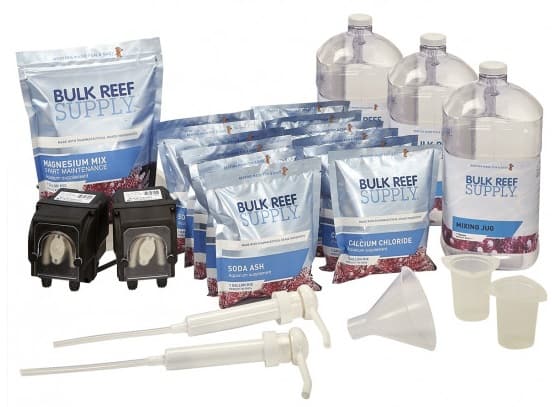
You can find the Bulk Reef Supply Starter Kit with Dosing Pumps HERE
or
2. Purchase a Stand Alone dosing pump system and run it with the 2-Part Starter Kits.
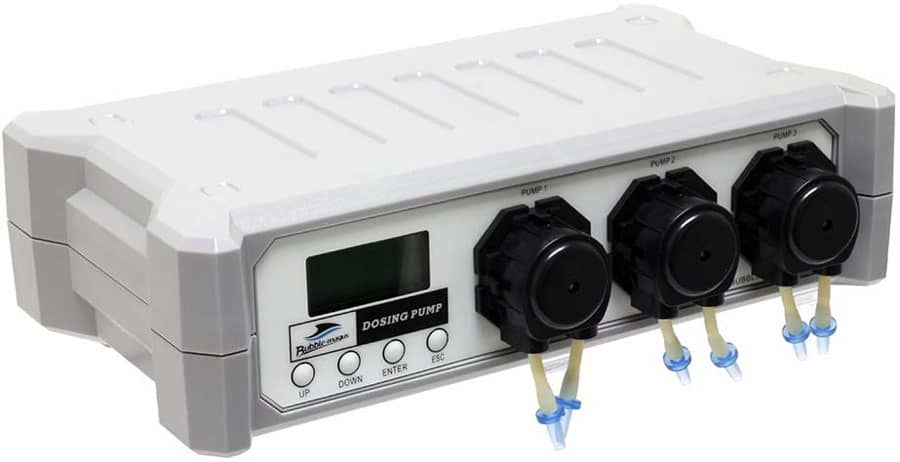
You Can Find a Great Selection of Dosing Pumps Here at Amazon.com
and find out even more information on Dosing Pump systems in this article:
What Is An Aquarium Dosing Pump?
4. Calcium Reactors
These are not for the Beginner, but something you can work up to if you get a big aquarium.
For the most part, dosing the liquid mixes above will suffice but when you have a large aquarium +150 Gallon) full to the brim of SPS, then a Calcium Reactor setup will be the best option – But they are not cheap!
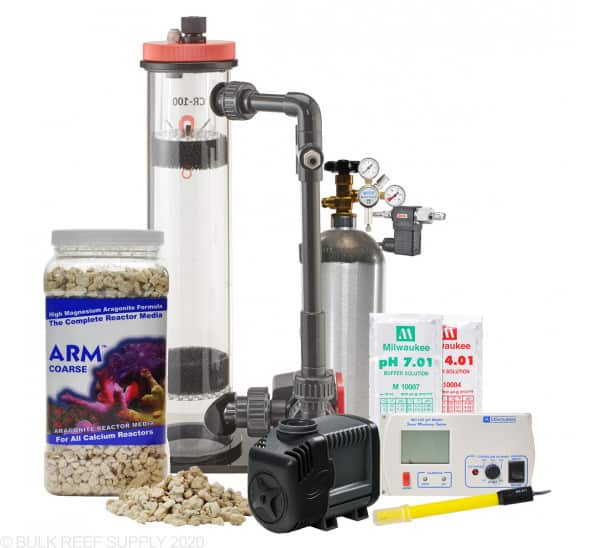
A Calcium Reactor is a tube filled with dead coral skeleton pieces that has Carbon Dioxide injected into the tube. The CO2 dissolves the dead coral skeleton and all the trace ions dissolve into the water.
This water then drips into your aquarium at a controlled rate that you set to meet the demand and the whole system is monitored by a Ph controller. Because you are melting dead coral, all the ions that were bound up in the dead coral skeleton are now released for your new coral skeletons.
Calcium Reactors work really well, but they are a complex system that you need to really understand and are beyond the scope of this article. They need an entire article dedicated to them!
What Time Do You Dose A Reef Tank?
It is recommended to dose Alkalinity during daylight hours and Calcium during opposite night time hours. Dosing Alkalinity and Calcium in a saltwater aquarium needs to be done at sepearte times. Dosing together will cause the Calcium to precipitate out of the water and turn it cloudy.
In layman’s terms, Precipitation is the Calcium undissolving from the water. Once it precipitates, your corals are unable to absorb the Calcium.
To prevent this, most aquarists set up dosing routines in two possible ways:
- If the amount you have to add each day is small then you dose:
Alkalinity in the morning as the majority of Alk is used during the day
Then dose Calcium in the evening - If you have an automated doser or you have a large amount to dose each day then dose:
Alkalinity on the odd hours x12
Calcium on the even hours x12 - Magnesium is dosed as required to maintain your desired parameter. No more than 100ppm per day for an increase though 😉
To Finish
For the majority of beginners to a saltwater aquarium,, it is going to be a while before you may have to begin dosing. Some of you may never need to dose at all.
But when you do, there is so much information from Bulk Reef Supply, especially in their YouTube videos that it is a simple process to get set up and get started.
I think the BRS Starter Kits are now the Go-To method for every aquarist starting dosing! Once you begin to get the hang of it and really like LPS and SPS coral it is easy to meet their consumption.
Just test every week, keep a journal and you will be able to see any trends of declining element parameters so you can then start on this next fun aspect to our great hobby!
Further Reading
For further details or more in-depth information to some items mentioned in this article you may find the following articles from us helpful:

